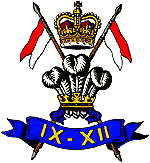9th/12th Royal Lancers
| 9th/12th Royal Lancers (Prince of Wales's) | |
|---|---|
 Cap Badge of the 9th/12th Royal Lancers | |
| Active | 11 September 1960 – 2 May 2015 |
| Allegiance |
|
| Branch |
|
| Type | Cavalry |
| Role | Formation Reconnaissance |
| Size | One regiment |
| Part of | Royal Armoured Corps |
| Garrison/HQ |
RHQ: South Wigston, Leicester Regiment: Hohne, Germany |
| Nickname(s) | The Delhi Spearmen[1] |
| Motto | Ich Dien (I Serve) |
| March |
Quick: God Bless the Prince of Wales Slow: Men of Harlech, The Coburg March |
| Anniversaries | Mons/Moy |
| Commanders | |
| Colonel-in-Chief | HRH The Duke of York |
| Colonel of the Regiment | Major-General J.H.T. Short CB OBE |
| Insignia | |
| Tactical Recognition Flash |
 |
| Identification symbol |
Prince of Wales's feathers from 12th Dragoons |
| Abbreviation | 9/12 L |
The 9th/12th Royal Lancers (Prince of Wales's) was a cavalry regiment of the British Army, formed in 1960 by the amalgamation of the 9th Queen's Royal Lancers and the 12th Royal Lancers. It was a formation reconnaissance regiment, equipped with the Combat Vehicle Reconnaissance (Tracked) family of vehicles and was attached to the 7th Armoured Brigade, the Desert Rats. The regiment was based in South Wigston, Leicestershire, along with its affiliated Territorial Army unit, The Leicestershire and Derbyshire Yeomanry, which formed B Squadron of The Royal Yeomanry. It amalgamated with the Queen's Royal Lancers on 2 May 2015 to form the Royal Lancers
History
_(CVR(T))_Operating_in_Afghanistan_MOD_45153171.jpg)
The amalgamation of the 9th Queen's Royal Lancers and the 12th Royal Lancers took place on 11 September 1960 in Tidworth Garrison Church.[2]
The inscription reads:
"Here on the 11 September 1960, 9th/12th Royal Lancers (Prince of Wales's) was formed by the 9th Queen’s Royal Lancers and the 12th Royal Lancers (Prince of Wales's) coming together before God. It is not the beginning but the continuing of the same until it be thoroughly finished, which yieldeth the true glory."
On 10 May 1972 the regiment received the Freedom of Derby and in January 1975 the whole regiment was deployed Armagh for a four month tour during the Troubles.[2] Squadrons were sent on tours to Cyprus in the late 1980s during the emergency there.[3]
D Squadron deployed to the Middle East in 1991 on Operation Granby to provide Battle Casualty Replacements.[3] The regiment was once again at the forefront in 1992 as part of the deployment to Bosnia on Operation Grapple 1.[4]
In 1999 the regiment was deployed to Canada as the 'opposing force' for training battlegroups.[5]
The regiment took part in Operation Telic in Iraq providing units for Telic 3 in 2004 and then Telic 7 in 2005.[6] It also provided a number of sub units which were deployed on Telic 12 in 2008. In addition, the regiment provided units for Operation Herrick 14 in Afghanistan in 2011.[7]
In 2012, as part of the Army 2020 reforms intended to reduce the size of the British Army in line with the Strategic Defence and Security Review, it was announced that the 9th/12th Royal Lancers would be amalgamated with the Queen's Royal Lancers to form a single regiment, The Royal Lancers, in 2015.[8]
Battle honours
The regiment carries the following battle honours awarded to its predecessors:[9]
- Egypt, Salamanca, Peninsula, Waterloo, Punniar, Sobraon, Chillianwallah, Goojerat, Punjaub, South Africa 1851–53, Sevastopol, Delhi 1857, Lucknow, Central India, Charasiah, Kabul 1878, Kandahar 1880, Afghanistan 1878–80, Modder River, Relief of Kimberley, Paardeberg, South Africa 1899–1902
- Great War: Mons, Retreat from Mons, Marne 1914, Aisne 1914, Messines 1914, Ypres 1914–18, Somme 1916–18, Arras 1917, Cambrai 1917–18, Rosieres, Sambre, Pursuit to Mons
- Second World War: Dyle, Dunkirk 1940, Somme 1940, NW Europe 1940, Chor Es Sufan, Gazala, Rusweisat, El Alamein, El Hamma, Tunis, N Africa 1941–43, Lamone Bridgehead, Argenta Gap, Bologna, Italy 1944–45
Mons Moy
Mons Moy is the weekend that the regiment, both serving and old comrades, remember the fallen of all conflicts. Where commitments allow, it falls between 28 August and 7 September. On 28 August 1914 at Moy, the 12th Royal Lancers (Prince of Wales's) successfully charged against the German Guard Dragoons.[10]
Regimental Collect
"O Eternal God, grant to us, thy servants of the 9th/12th Royal Lancers, strength, guidance, courage, and steadfast Faith, that we may ever serve thee truly; and finally by thy mercy attain everlasting glory, through Jesus Christ our Lord – Amen".[11]
Regimental Museum
The Regimental Museum Display is housed within the Soldier’s Story gallery at Derby Museum and Art Gallery.
Alliances
Affiliations
- B (Leicestershire and Derbyshire (Prince Albert's Own) Yeomanry) Squadron, Royal Yeomanry
- HMS Tireless
- B Squadron, Leicestershire, Northamptonshire & Rutland Army Cadet Force
- Bedfordshire & Hertfordshire Army Cadet Force
References
- ↑ Acquired during the Indian Mutiny, 1857
- 1 2 Brief History, page 12
- 1 2 Brief History, page 14
- ↑ Brief History, page 15
- ↑ Brief History, page 16
- ↑ Brief History, page 18
- ↑ Brief History, page 19
- ↑ "Army 2020 announcement". Ministry of Defence. 5 July 2012. Retrieved 3 May 2014.
- ↑ "9th/12th Royal Lancers". Retrieved 3 May 2014.
- ↑ Brief History, page 9
- ↑ Brief History, page 2
Further reading
- A Brief History of the 9th/12th Royal Lancers (Prince of Wales's)
- Brockbank, R & Collins, RM. A Short History of the XII Royal Lancers 1945–60. Polestar Wheatons Ltd
- Hanwell (1949). A Short History of the 9th Queen's Royal Lancers 1715–1949. Aldershot: Gale & Polden Ltd.
- Stewart MC, PF. History of the XII Royal Lancers. Oxford University Press.
External links
- 9th/12th Royal Lancers Official website
- Regimental Museum
- 9th/12th Royal Lancers (Prince of Wales's) Charitable Association
- British Army Locations from 1945
| ||||||||||||||||||||||||||||||||||||||||||||||||||||||